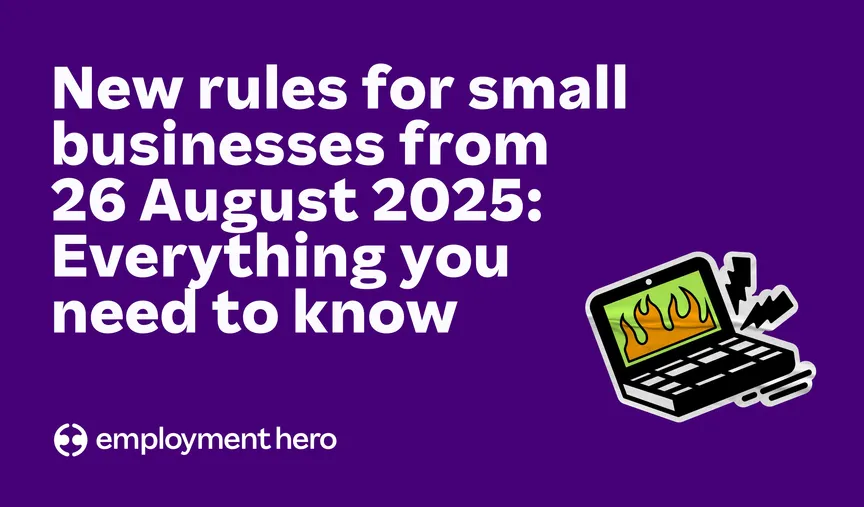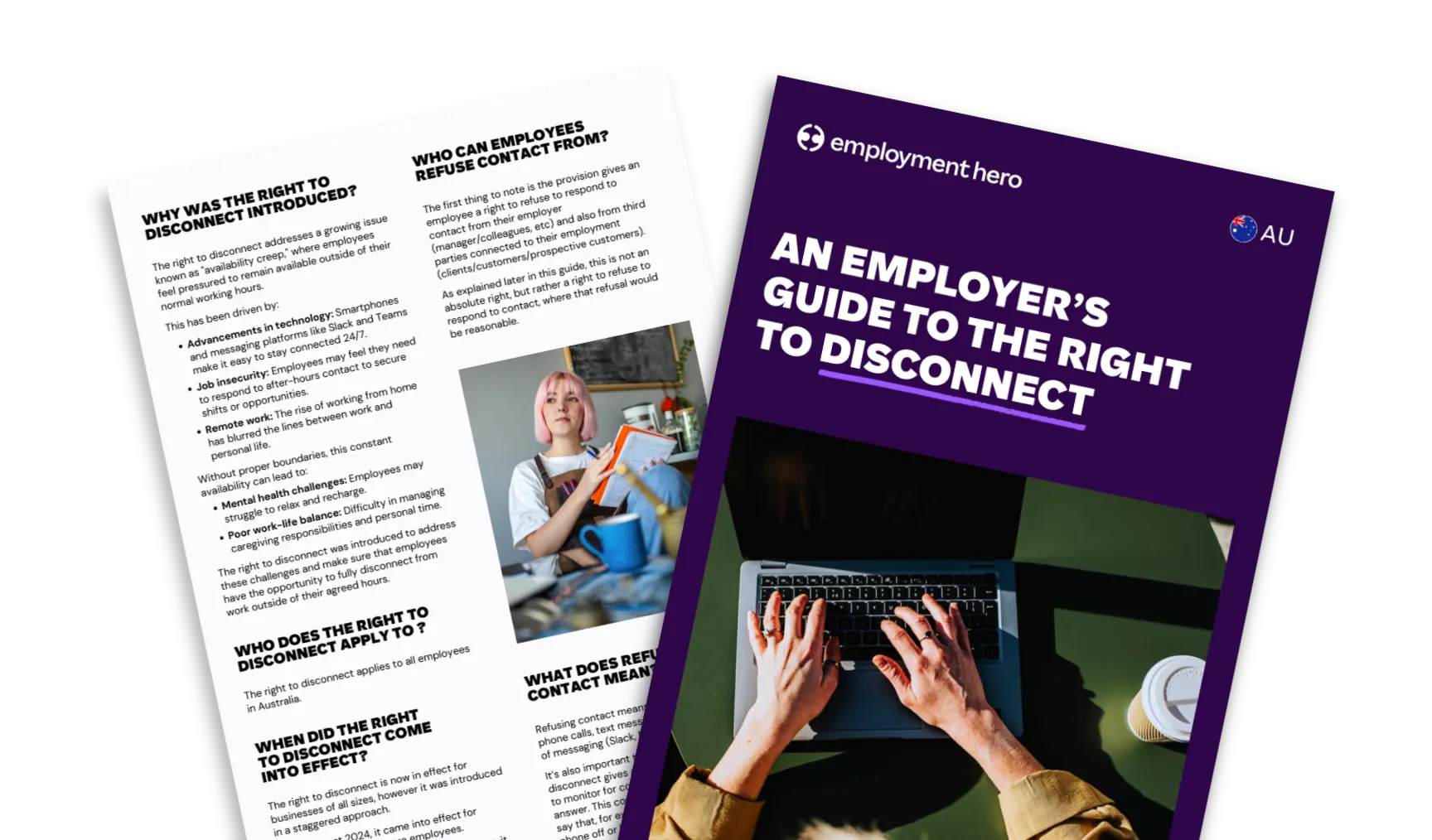New rules for small businesses from 26 August 2025: What you need to know
From 26 August 2025, new rules impact small businesses. Learn what’s changing and how to get ready for a smooth transition.
Last Updated

Contents
From 26 August 2025, two important employment law changes come into effect for small businesses with under 15 employees. These changes will see the ‘Right to Disconnect’ and the ‘Employee Choice’ pathway for casual employees apply to small businesses.
These changes have been introduced to give employees more control over their work-life balance and employment status. However, like with any change to workplace laws, they also bring new responsibilities and obligations for employers. Understanding what’s changing and how to manage it in your workplace can help keep things running smoothly.
We’ll break down what each change means, how it applies to your business and how Employment Hero can help your small business get prepared.
Disclaimer: The information in this article is current as at 12 August 2025, and has been prepared by Employment Hero Pty Ltd (ABN 11 160 047 709) and its related bodies corporate (Employment Hero). The views expressed in this article are general information only, are provided in good faith to assist employers and their employees, and should not be relied on as professional advice. The Information is based on data supplied by third parties. While such data is believed to be accurate, it has not been independently verified and no warranties are given that it is complete, accurate, up to date or fit for the purpose for which it is required. Employment Hero does not accept responsibility for any inaccuracy in such data and is not liable for any loss or damages arising either directly or indirectly as a result of reliance on, use of or inability to use any information provided in this article. You should undertake your own research and to seek professional advice before making any decisions or relying on the information in this article.
New rule #1: The Right to Disconnect
The Right to Disconnect Bill amended the Fair Work Act to give employees the legal right to step away from work communications outside of their normal working hours. For businesses with over 15 employees, it came into effect on 26 August 2024. One year later (26 August 2025), it will apply to small businesses with under 15 employees.
The rules mean that employees are not expected to monitor, read or respond to any unreasonable contact from their employer outside of their working hours.
It’s important to be aware that the legislation doesn’t ban after-hours contact entirely. However, it does protect employees from being penalised if they choose not to respond if it’s deemed unreasonable.
In simple terms, this change means that if an employee was to ignore messages or communications sent to them outside of working hours, they will not be punished for it.
For more information, download our factsheet on the right to disconnect or read our Q&A from our Head of HR Advisory on the right to disconnect.
When does the Right to Disconnect come into effect for small businesses?
If your business has fewer than 15 employees, you’ll need to comply with the new Right to Disconnect rules from 26 August 2025.
What is deemed reasonable and unreasonable contact?
When it comes to the Right to Disconnect, context is key. Think about the nature of the role and whether it’s reasonable to expect the employee to be available outside their normal working hours.
For example, contacting a doctor who is on-call and needs to be reachable after hours would be considered reasonable contact. The same could apply to roles where urgent matters might arise and immediate action is necessary.
On the other hand, if you employ a casual team member or someone contracted to work a standard full-time or part-time schedule, expecting them to respond after hours about non-urgent work-related matters is more likely to be seen as unreasonable.
For employers, knowing the difference between reasonable and unreasonable contact is essential. By clearly outlining expectations in employment contracts and workplace policies, you’ll meet your legal obligations and prevent any potential misunderstandings with your team.
How can small businesses get prepared for the Right to Disconnect?
As with any change to employment law, it’s essential that employers are prepared for the change and introduce measures that can minimise their risk of non-compliance.
One effective way to do this is to inform your team and managers of the changes coming into place. Consider creating a new workplace policy (which you can find in Employment Hero), implementing training to bring awareness to it and have your team acknowledge it before it comes into effect.
You can also prepare policies around technology use outside of agreed working hours and encourage boundary setting. This includes the understanding that, unless expressly stated, after-hours communication does not warrant an immediate response.
Employment Hero can help you navigate these changes in-platform
Easily add a Right to Disconnect clause to your employment contracts
When creating Australian employment contracts in-platform, you’ll have the option to include a Right to Disconnect clause, which will set an expectation that employees will be required to respond to reasonable out-of-hours contact.
This can give employers the compliance confidence they need to navigate this new legislation by setting clear expectations and boundaries.
Create and distribute a Right to Disconnect policy to your team
To better manage your employer obligations under the new Right to Disconnect, we’ve included a new policy template in-platform.
By issuing a policy to your team, you can be confident they know their obligations when it comes to replying to messages or calls after work. You can issue the new Right to Disconnect policy in-platform, where your employees may be required to digitally sign and acknowledge it.

New rule #2: The ‘Employee Choice’ pathway for casual employees
From 26 August 2025, eligible casual employees employed by a small business (under 15 employees) will have the option to notify their employer if they want to switch to permanent employment, either in a full-time or part-time capacity. This new change is known as the ‘Employee Choice’ pathway. If employees do not wish to transfer to permanent employment, they can choose to remain casual.
As an employer, you’re required to respond in writing, within 21 days, to any requests you receive from your casual team members. While you can refuse a request in certain situations, it’s key to handle these responses carefully and fairly.
Understanding how to manage these requests will help you support your employees while keeping your business running smoothly.
How do the new casual conversion rules work?
From 26 August 2025, the new “employee choice” provisions operate so that casual employees in small businesses can choose to request to convert to permanent employment (once they have been employed for 12 months and if they no longer meet the definition of a true casual employee).
When do the new rules take effect?
Eligible employees can request to convert from casual to permanent employment from 26 August 2025.
For an in-depth look at how the new conversion rules work for small businesses, download our ultimate guide to understanding the casual conversion process. It covers everything you need to know, including:
- The new process for casual conversion
- The new definition of Casual Employee
- How to respond to an employee’s request to convert
- A comparison between old and new casual conversion rules
- Practical examples of when an employee will and will not meet the new definition of casual employee

Stay up to date with employment law updates with Employment Hero
With workplace changes coming into effect for small businesses from 26 August 2025, it’s never been more important to stay on top of your obligations.
We know that for small business owners, keeping up with constant employment law changes can feel like an uphill battle. Between dense legal jargon, lengthy legislation, and not having an HR expert or lawyer on hand, it’s easy to feel overwhelmed and confused.
That’s where Employment Hero comes in. Our all-in-one Employment Operating System helps you manage everything employment, from HR, recruitment, payroll and everything in between. And with our HR advisory service, you’ll have access to expert guidance whenever you need it, so you can focus on growing your business instead of deciphering legislation.
Keen to learn more about how Employment Hero can support your business? Chat with one of our business specialists today.
Related Resources
-
 Read more: Australian Employment Law Updates in 2025 Factsheet
Read more: Australian Employment Law Updates in 2025 FactsheetAustralian Employment Law Updates in 2025 Factsheet
Download our employment law updates factsheet to see the changes in employment laws this 2025.
-
 Read more: Casual conversion to permanent employment: Employer guide
Read more: Casual conversion to permanent employment: Employer guideCasual conversion to permanent employment: Employer guide
Learn how to manage casual conversion under the new rules. Understand eligibility, timeframes, employer obligations and compliance steps.
-
 Read more: Right to disconnect: what employers need to know
Read more: Right to disconnect: what employers need to knowRight to disconnect: what employers need to know
Understand Australia’s new Right to Disconnect laws. Learn employer obligations, what’s considered unreasonable contact and how to resolve disputes.























